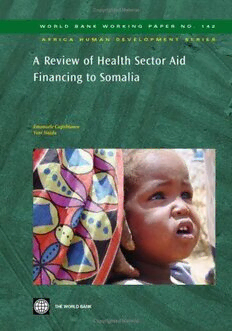
A Review of Health Sector Aid Financing to Somalia (World Bank Working Papers) (World Bank Working Papers; Africa Human Development) PDF
70 Pages·2008·0.854 MB·English
Most books are stored in the elastic cloud where traffic is expensive. For this reason, we have a limit on daily download.
Preview A Review of Health Sector Aid Financing to Somalia (World Bank Working Papers) (World Bank Working Papers; Africa Human Development)
Description:
This study reviews aid flows to the health sector in Somalia over the period 2000-2006. In close collaboration with the Health Sector Committee of the Coordination of International Support to Somalis the authors collected quantitative and qualitative data from twenty-six international agencies operating in Somalia, including bilateral and multilateral donors. The paper reaches three main conclusions. First, aid financing to the health sector in Somalia has been constantly growing, reaching US$ 7-10 per capita in 2006. Although this is a considerable amount compared to other fragile states, it may still be insufficient to address the population s needs and to meet the high operational costs to work in Somalia. Secondly, contributions to the health sector could and should be more strategic. The focus on some vertical programs (e.g. HIV/AIDS and malaria) seems to have diverted attention away from other important programs (e.g. immunization and reproductive health) and from basic health system needs (infrastructure, human resources, etc.). The third conclusion is that more analytical work on health financing is needed to drive policy decisions in Somalia. Similarly to other fragile states, quality information on health sector financing is scanty, thus affecting the policy making process negatively.
See more
The list of books you might like
Most books are stored in the elastic cloud where traffic is expensive. For this reason, we have a limit on daily download.
